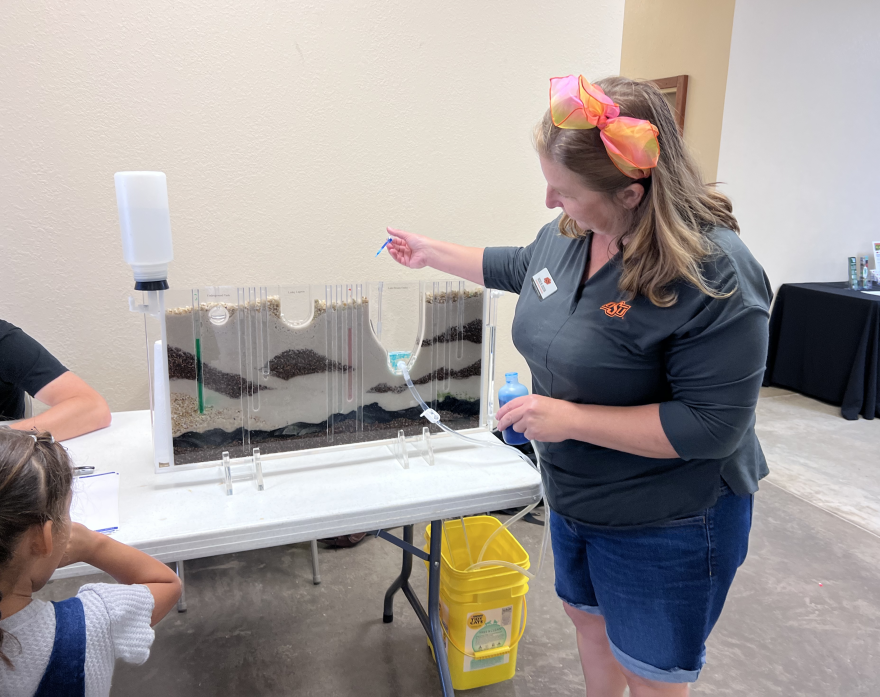Southern Oklahoma residents gathered in a steel barn in Tishomingo for the Johnston County Fair last weekend. Fairgoers had more than just prize-winning livestock and local art to look forward to — this year, the OSU Extension Office offered free well water testing at the fair as part of its Oklahoma Well Owner Network.
“I've been really excited about it since we saw it in the newspaper, said Dean Ross, who lives north of Tishomingo. “I told my wife, I said, ‘Write a big note, put it on the table so we can remember.’”
Ross uses his well to water his garden and for his cows, but he and his family don’t drink it.
“We are concerned about our water,” Ross said. “I'm encouraged, and I was just excited to come today and bring our water now and get the results. We’ll see, I might be able to make my coffee out of that water.”
Ross said his family’s well water is softer than what they get from their rural water district. But before he adds it to his coffee pot, he wants to make sure it isn’t contaminated with bacteria or fertilizer from agricultural runoff.
Nicole Colston with the Oklahoma Water Resource Center said most water contaminants come from close to home.
“When we put something on the surface, it stays and it's in our water system,” Colston said. “There's this perception that our water comes from Colorado down a mountain and it's all pristine, but actually most of our water and our water system stays pretty close to home.”
At a booth near the entrance to the fair, Colston demonstrated this with a groundwater simulator. Between sheets of plexiglass sat layers of sand and gravel and other rocks.
“Lots of people say it looks like an ant farm,” Colston said.
But instead of ants, the display shows water creeping through the ground from wells, septic tanks and wetlands.

“We've been polluting different parts of our groundwater display and watching how the pollution moves through the water,” Colston said.
The “pollution” is food coloring, and kids at the fair gathered around to watch it spread quickly through the rock layers, then slowly through the sand. Colston added the water table to simulate rain or opened a drain to recreate drought.
In real life, well contamination isn’t quite so colorful. Don Simmons is a Southern Oklahoma resident who recently bought a house. His realtor suggested they test the well, which turned out to have bacterial contamination. The previous homeowners tried to get rid of it.
“All he did to shock the well is went into the pump house and pulled the cap off of the well and poured bleach down the well,” Simmons said.
But another test came back positive for bacteria, so they shocked the well again. Simmons brought in a sample to the fair to make sure that worked.
“I have no reason to think that it was re-contaminated,” Simmons said. “But I don't know why it was in the first place. I don't know what did it.”
To prepare his sample, Simmons washed his hands and emptied a new plastic water bottle. Then he rinsed it with well water a few times before filling it up and bringing it in.
“It's a pretty simple process to do,” Simmons said.
Colston said the tricky part comes after you’ve collected a sample.
“It's challenging to get your water tested in Oklahoma,” she said. “There aren't a lot of options. DEQ and OSU have water testing facilities, but for things like E. coli, it's not always feasible because it will have to stay cold.”
That’s why county fairs are a great venue for this program — people are already going to be there, and Extension agents can keep the samples on ice and make sure they get tested within the right time frame.

Well owners who dropped off samples in Johnston County should hear back about their water within a week. They’ll receive their results, along with information about how to treat and prevent well contamination.
OSU Extension researchers are getting something out of this, too.
“We don't have a good sense of how many household wells there are or what issues are facing particular regions,” Colston said. “So another important reason to bring your well sample in is for science, so that we can understand and take some next steps toward protecting our water resources.”
Ross said he’s glad people in his area are starting to pay closer attention to their water resources.
“I just remember way back when Robert S. Kerr said that water would be more important than oil someday,” Ross said. “You could have oil, but if you don't have water, we're not going to have anything.”
OSU Extension has more county fair well water testing lined up in the coming weeks. The next stop is the Osage County Free Fair in Pawhuska. OSU Extension will be accepting well water samples there this weekend.







